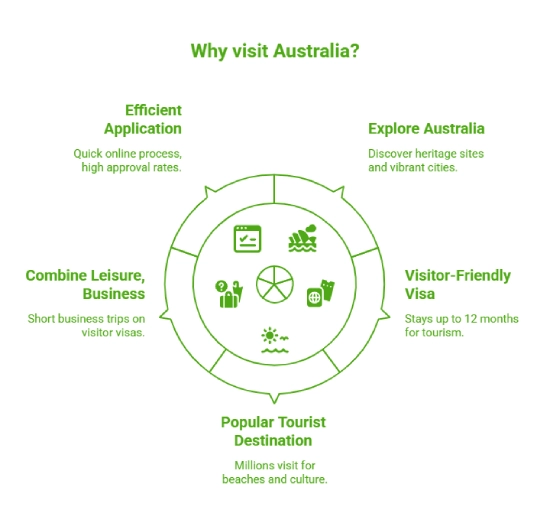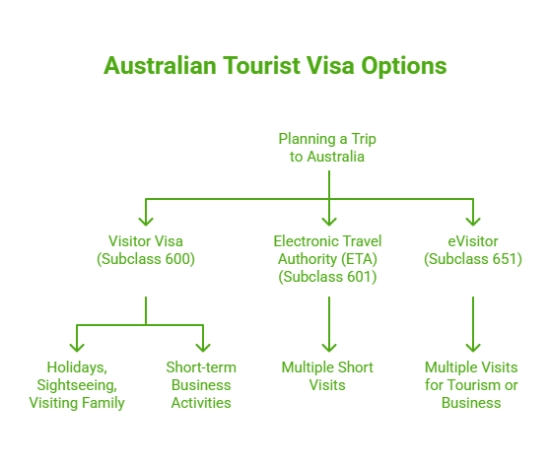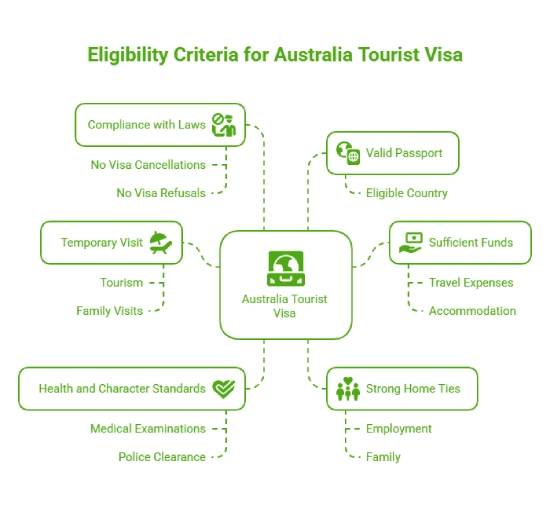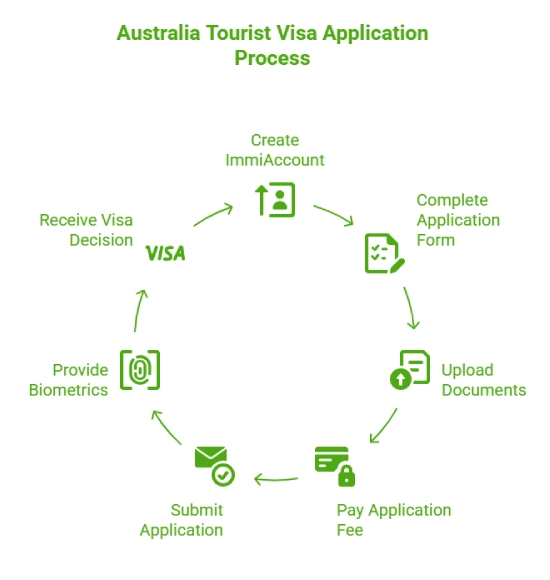
The Australia Tourist Visa is ideal for those planning a holiday, visiting family and friends, or exploring the country’s breath-taking landscapes and vibrant cities. This visa allows stays of up to 3, 6, or 12 months, depending on your travel plans. The most common options are the eVisitor visa (subclass 651), ETA (subclass 601), and Visitor Visa (subclass 600). The application process is straightforward and can be completed online, making it convenient for travellers to secure their visa before departure. With its world-renowned beaches, vibrant cities, and unique wildlife, Australia attracts over 9 million visitors annually, making it one of the most sought-after destinations globally.
Australia offers different types of tourist visas to suit various travel purposes, from leisure holidays to visiting family and friends. Each visa type has specific features and eligibility criteria.
This visa is ideal for tourists visiting Australia for holidays, sightseeing, or visiting family and friends. It allows stays of up to 3, 6, or 12 months and can also be used for short-term business visitor activities.
Designed for passport holders from certain countries, including the UK, this visa allows multiple short visits of up to 3 months per entry within a 12-month validity period.
Available to passport holders of specific European countries, including the UK, this visa allows multiple visits to Australia for tourism or business purposes for up to 3 months at a time during a 12-month period.

The table below gives you a complete overview of the different types of Australian tourist visas:
| Visa Type | Stay Duration | Who Can Apply | Application Mode | Fee |
| Visitor Visa (600) | Up to 12 months | All nationalities requiring a visa | Online via ImmiAccount | AUD 195 |
| ETA (601) | Up to 3 months/visit | Eligible nationals incl. UK, US, CA | ETA app / Airline / Travel Agent | AUD 20 |
| eVisitor (651) | Up to 3 months/visit | EU & EFTA citizens, including UK | Online via ImmiAccount | Free |
An Australia Tourist Visa allows you to experience the country’s world-class attractions while offering the flexibility and convenience travellers need. Whether you’re planning a holiday, visiting loved ones, or exploring business opportunities, this visa comes with several advantages.
To qualify for an Australia Tourist Visa, applicants must meet specific requirements set by the Department of Home Affairs (DHA), such as:

The requirements to apply for an Australian tourist visa are as follows:
You can follow the below steps to apply for an Australian tourist visa:
Step 1: Choose the appropriate visa subclass based on travel purpose
Step 2: Create an ImmiAccount or use the ETA app (if applicable)
Step 3: Fill in the application form, upload documents, and pay applicable fees
Step 4: Submit biometrics and health checks, if required
Step 5: Track your application using your ImmiAccount or ETA app
Step 6: Receive your visa grant notice, linked electronically to your passport

| Visa & Stream | 50% of Applications | 90% of Applications |
| Visitor Visa – Tourist | 13 days | 27 days |
| Visitor Visa – Business | 24 days | 39 days |
| Visitor Visa – Family | 36 days | 87 days |
| eVisitor (651) | 1–14 days | – |
| ETA (601) | A few days | – |
| Visa Type | Fees |
| Visitor Visa (Subclass 600) | 195 AUD |
| Electronic Travel Authority (ETA) (Subclass 601) | Free |
| e-Visitor (Subclass 651) | Free |
Australia offers varying stay durations depending on the type of visitor visa granted:
As the leading overseas immigration consultancy in the UK, Y-Axis has been providing dedicated immigration assistance to its customers for more than 25 years. Our team of visa and immigration experts will give end-to-end guidance for all your immigration needs:
Sign up with Y-Axis for complete assistance with Australia Immigration!
Yes, UK passport holders are eligible to apply online for an Australian visitor visa via ImmiAccount. Options include Visitor Visa (Subclass 600) for longer stays, Electronic Travel Authority (Subclass 601), and eVisitor (Subclass 651). You must choose the correct visa stream based on your travel purpose—tourism, visiting family, or attending short-term business—and ensure you meet eligibility criteria such as valid documentation, financial capacity, and clear intent to return. Submit your application with all required details and fees, and you can follow its progress through ImmiAccount, which provides status updates and further instructions.
Yes, UK citizens must obtain a valid visa before travelling to Australia, even for short visits. The two most commonly used visas are the eVisitor visa (subclass 651) and the Visitor Visa (subclass 600). The eVisitor is free, can be applied for online, and is typically granted for multiple short stays (up to three months each) within a 12-month period. The Visitor Visa offers broader options such as extended stay periods or multiple entries. Both options require online applications and must be approved before you enter Australia. Visa-free travel is not available to UK passport holders.
For UK citizens planning a holiday in Australia, the eVisitor visa (subclass 651) is generally the most convenient option. It allows you to stay in Australia for up to three months per visit and is valid for multiple entries within a 12-month period. The application is free and processed online, often within a few days. If you require longer stays or have unique travel needs, you may consider the Visitor Visa (subclass 600), which offers more flexibility but involves a fee and longer processing times. The best visa depends on your intended stay and purpose of travel.
A visitor visa cannot be officially “converted” into another visa, but you may be eligible to apply for a new visa while in Australia under certain conditions. If your current visa does not have a “no further stay” condition, you may apply for a student visa (subclass 500) or a work visa (such as subclass 482) while still onshore. You must meet the eligibility requirements of the new visa, and your application must be submitted before your current visa expires. It is highly recommended to consult a registered migration agent for personalised advice before applying.
Depending on your personal circumstances and the type of visa you are applying for, the Australian government may require you to complete health and character checks. These may include a medical examination, chest X-ray, or proof of good health, particularly if your stay exceeds six months or you are from a country with specific health risks. All applicants must also meet character requirements, which usually involve declaring any criminal history and, in some cases, providing police clearance certificates. The Department of Home Affairs will assess your health and character information as part of the visa decision process.
Processing times for an Australian visitor visa depend on the visa type and your personal situation. For the eVisitor visa (subclass 651), most applications are processed within 1 to 14 days. The Visitor Visa (subclass 600) generally takes longer—anywhere from 10 to 30 business days or more, depending on the volume of applications and the completeness of the documents submitted. Delays may also occur if health or character checks are required. To avoid last-minute issues, it is advisable to apply several weeks before your intended departure date.
Processing times vary depending on the visa category and completeness of your application. For Visitor Visa (Subclass 600), around 75% of applications are processed within approximately 20 days, and 90% within 33 days. ETA (Subclass 601) and eVisitor (Subclass 651) applications are typically granted within 1–2 business days. Delays may occur during peak travel seasons or if additional documents are requested. Ensuring your application is thorough, complete, accurate, and supported by documentation—helps achieve quicker outcomes. You can monitor exact timelines through ImmiAccount, which offers personalized updates on your application’s progress.
Visitor, ETA, and eVisitor visas do not permit study beyond three months and cannot be converted into a Student Visa (Subclass 500) within Australia. If you plan to study for a course longer than three months, you must exit Australia and apply offshore for the correct student visa. This includes obtaining a Confirmation of Enrolment (CoE), meeting English proficiency requirements, and providing evidence of financial support. Processing for Student Visas is separate and may take several weeks. Therefore, planning your educational pathway and visa timeline ahead is essential to avoid overstaying or detaining on incorrect visa conditions.
The fees for Australian visitor visas are as follows: Visitor Visa (Subclass 600) costs AUD 195; ETA (Subclass 601) requires a service charge of AUD 20; and eVisitor (Subclass 651) is free of charge. Fees are payable online through ImmiAccount and are non-refundable, even if the application is withdrawn or denied. Additional charges may apply if optional health checks or translations are required. Always confirm current fee schedules on the official Department of Home Affairs website before applying, as costs may be revised.
Applicants must submit recent financial documents—commonly three months of bank statements to demonstrate sufficient funds for travel, accommodation, and other expenses. Typically, evidence of AUD 5,000–7,000 per person is sufficient for short visits, though amounts may vary depending on stay length, travel plans, and whether you are self-funded or sponsored. Supplement your statements with payslips, tax returns, or proof of assets to strengthen your application. Properly evidencing financial capacity helps assure visa officers of your intent to return and reduces the risk of refusal due to insufficient funds.
The official visa costs are: AUD 195 for Visitor Visas (Subclass 600); AUD 20 for ETA (Subclass 601); and AUD 0 for eVisitor (Subclass 651). These fees cover processing charges charged by the Department of Home Affairs and do not include any extra service fees from agents or optional express processing. Fees are paid during the application via ImmiAccount and are non-refundable. It’s essential to confirm the current fee schedule on the official Immigration website before submitting your application.
Note: Your visa letter will specify the exact duration granted. Exceeding your permitted stay may lead to penalties or future visa refusals. Always track expiry dates on your CoS and departure plans.
To apply for an Australia visit visa, you must provide a set of documents to support your application and demonstrate your eligibility.
Yes. If you wish to stay beyond your original Visitor Visa (Subclass 600) expiry, you may apply to extend it from within Australia, provided it is not subject to a “No Further Stay” condition. Use ImmiAccount to lodge your application before your current visa expires. You must demonstrate continued purpose of visit, ongoing financial capacity, and compliance with visa rules. Extensions are granted at the discretion of immigration officers. You must remain outside Australia if your visa cannot be extended or if you hold ETA/eVisitor visas, which are non-renewable in-country.
You can follow the below steps to submit your Australian visit visa application from the UK:
Step 1: Create an ImmiAccount on the official Department of Home Affairs website.
Step 2: Select the appropriate visa subclass (Visitor Visa 600, ETA 601, or eVisitor 651) based on your travel needs.
Step 3: Complete the online application form with accurate personal and travel details.
Step 4: Upload required supporting documents, including your passport, recent photographs, proof of funds, and travel itinerary.
Step 5: Pay the visa application fee securely through the online portal.
Step 6: Submit your application and monitor progress via ImmiAccount for status updates or additional document requests.
Step 7: If required, attend a biometrics appointment at an Australian Visa Application Centre (AVAC) in the UK.
Step 8: Await your visa decision and prepare for your trip once approved.
The eVisitor visa (subclass 651) is available exclusively to citizens of European countries. It provides a 12-month multiple-entry visa, with each stay allowed for up to three months. While the Department of Home Affairs publishes the complete eligibility list, it typically includes all EU member states, along with European microstates such as Iceland, Liechtenstein, Monaco, Norway, San Marino, Switzerland, and the Vatican. Travelers must hold a valid passport from an eligible country, and must intend visits for tourism or business purposes, while meeting health and character requirements.
The Frequent Traveller stream is a category under the Visitor Visa (subclass 600) designed for citizens of specific Asia-Pacific countries who frequently travel to Australia. This stream is available to individuals from China, Brunei, Cambodia, the Philippines, Laos, Indonesia, Malaysia, Singapore, Thailand, Vietnam, and Timor-Leste. It enables multiple entries, with the ability to stay for up to three months per visit, often for an extended validity period of up to 10 years, depending on assessment. Applicants must primarily travel for tourism or short-term business visits, and must meet all standard visitor visa requirements.
No. Visitor visas—such as eVisitor (651) or Visitor Visa (600)—are strictly for tourism, business visits, or leisure activities, and do not permit any form of employment. Attempting to work, including remotely for a foreign employer, violates visa conditions and may result in serious consequences, such as visa cancellation or deportation. If you are offered work or wish to pursue employment in Australia, you must apply for a specific work visa that allows such activity. Always adhere to your visa’s conditions to ensure legal and worry-free travel.